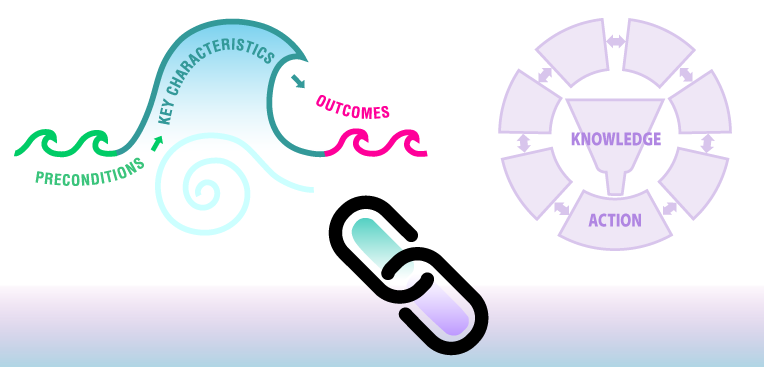

Linking this outcome to other elements of the Social Movement Action Framework:
Each of the elements of the Social Movement Action (SMA) Framework is dynamic and interrelated. For example -- change being scaled up, out, or deep (Grinspun, 2018; Grinspun et al., 2018a; McConnell et al, 2018)-- is a reflection of the focus of the individual and collective action and whether it is targeted to spreading the change (scaling up), changing standards (scaling out), or creating new norms and culture (scaling deep). As the achievement of scaling up, scaling out, or scaling deep typically requires time and ongoing involvement in the social movement, momentum is critical. A strong collective identity often inspires the speed and depth of change leveraging on an engaged network that shares support and resources (Serna Restrepo et al., 2018). Throughout the change, emerging leadership is needed with guidance from a core leadership structure such as a change team.
Linking this outcome to the action cycle phases of the Knowledge-to-Action Framework:
You and your change team’s capacity in social movement actions may be enhanced and/or accelerated by the addition of some of the action cycle phases of the Knowledge-to-Action (KTA) Framework, as the two frameworks are complementary. In addition to the two linking examples described earlier in this section, there can be many other points of connection between the two frameworks. Below are three more examples for your consideration:
- Adapt knowledge to local context: Whether your change is scaled up, scaled out, or scaled deep depends on 1) the context and setting to which the change is being applied; 2) the stakeholders that can be engaged to influence the change and ensure its success, and be influenced by it; and 3) the resources needed to scale your change.
- Select, tailor and implement interventions: Sometimes, it is necessary to tailor the change to the local setting and needs to which the change is being applied. For example, a small tweak in an intervention itself to accommodate limited resources and/or infrastructure for a local setting may be needed. As long as the change/intervention still keeps its core features and functions the way it intends to, the change can still be scaled up, scaled out, or scaled deep. This phase of the KTA action cycle can help you and your change team determines which parts of the change/intervention you can modify, and how to do so.
- Sustain knowledge use: Change can be scaled up, scaled out, or scaled deep, but it also must be maintained. Your invested resources and efforts may be wasted if your change is not sustained, no matter how widely and how much it spreads across organizations or communities. There are specific approaches and strategies you can use to ensure that your change is here to stay for the long term. This phase of the KTA action cycle can help you and your change team with sustaining your change.
For more discussion about the dynamic links between the elements of the SMA Framework to one another and to the KTA Framework, see the section ‘Accelerate your success with the Leading Change Toolkit™’.
